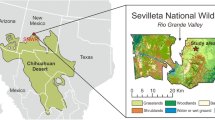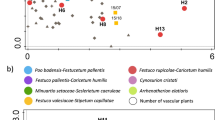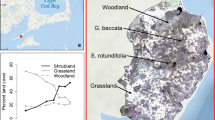Abstract
The cool season rainfall at our study site should favour C3 rather than C4 grasses. There are, however, several locations where C4 grasses have become dominant, suggesting that rainfall seasonality is not a constraint on distribution. Here, we explored the limitations on C4 grass distribution in a fynbos shrubland. Using δ13C values of SOM, we determined when these grasses had established. We also looked at the role of roads as conduits for establishment and asked what impact these grasses may have on fynbos species richness. We then conducted a field experiment designed to examine the extent to which soil moisture, nutrient availability, and competition with fynbos for resources influence the establishment and growth of the grasses. Finally using aerial photography, we explored the role of changes in land use on distribution. Our results showed that the establishment is recent, that roads may be acting as conduits, and that with establishment, there is a reduction in fynbos species richness and diversity. Disturbance and removing below-ground competition for resources open the system to establishment in wetter areas. This study is the first to look at the potential for C4 grasses expanding into cool season rainfall shrublands such as in Western Australia and South Africa. What is interesting about these results is that C4 grasses can establish and dominate in a cool season rainfall regime. Rather than temperature of the growing season, it is competition for resources from fynbos that prevents these grasses from encroaching.




Similar content being viewed by others
Data availability statement
The data used in this study are available on the University of Cape Town open access database at https://doi.org/10.25375/uct.12647057.
References
Araya YN, Silvertown J, Gowing DJ, McConway KJ, Peter Linder H, Midgley G (2011) A fundamental, eco-hydrological basis for niche segregation in plant communities. New Phytol 189:253–258
Balesdent J, Mariotti A (1996) Measurement of soil oganic matter turnover using 13C natural abundance. In: Boutton TW, Yamasaki S (eds) Mass spectrometry of soils. Marcel Dekker Inc, New York, pp 83–111
Beard J, Chapman A, Gioia P (2000) Species richness and endemism in the Western Australian flora. J Biogeogr 27:1257–1268
Bentley LK, O’Connor TG (2018) Temperature control of the distributional range of five C3 grass species in the uKhahlamba-Drakensberg Park, KwaZulu-Natal, South Africa. Afr J Range Forage Sci 35:45–54. https://doi.org/10.2989/10220119.2018.1459841
Bond WJ (2008) What limits trees in C4 grasslands and savannas? Annu Rev Ecol Evol Syst 39:641–659
Boström B, Comstedt D, Ekblad A (2007) Isotope fractionation and 13C enrichment in soil profiles during the decomposition of soil organic matter. Oecologia 153:89–98
Bouchenak-Khelladi Y, Slingsby JA, Verboom GA, Bond WJ (2014) Diversification of C4 grasses (Poaceae) does not coincide with their ecological dominance. Am J Bot 101:300–307
CapeNature (2016) De Hoop Nature Reserve Complex: Protected Area Management Plan 2017–2022. Cape Nature, Internal Report, Cape Nature, Cape Town
Chatanga P, Sieben EJ (2019) Ecology of palustrine wetlands in Lesotho: vegetation classification, description and environmental factors. Koedoe 61:1–16
Cione NK, Padgett PE, Allen EB (2002) Restoration of a native shrubland impacted by exotic grasses, frequent fire, and nitrogen deposition in southern California. Restor Ecol 10:376–384
Colville J et al (2015) Floristic and faunal Cape biochoria: do they exist? Oxford University Press, Oxford
Connin SL, Virginia R, Chamberlain C (1997) Carbon isotopes reveal soil organic matter dynamics following arid land shrub expansion. Oecologia 110:374–386
Cowling R (1983) The occurrence of C3 and C4 grasses in fynbos and allied shrublands in the South Eastern Cape, South Africa. Oecologia 58:121–127
D’Antonio CM, Vitousek PM (1992) Biological invasions by exotic grasses, the grass/fire cycle, and global change. Annu Rev Ecol Syst 23:63–87
Ehleringer JR, Cerling TE, Helliker BR (1997) C4 photosynthesis, atmospheric CO2, and climate. Oecologia 112:285–299
Ehleringer JR, Buchmann N, Flanagan LB (2000) Carbon isotope ratios in belowground carbon cycle processes. Ecol Appl 10:412–422
February EC, Allsopp N, Shabane T, Hattas D (2011) Coexistence of a C4 grass and a leaf succulent shrub in an arid ecosystem. The relationship between rooting depth, water and nitrogen. Plant Soil. https://doi.org/10.1007/s11104-011-0867-y
February EC, Cook GD, Richards AE (2013) Root dynamics influence tree–grass coexistence in an Australian savanna. Austral Ecol 38:66–75. https://doi.org/10.1111/j.1442-9993.2012.02376.x
Fey M (2010) Soils of South Africa. Cambridge University Press, Cambridge
Fish L, Mashau A, Moeaha M, Nembudani M (2015) Identification guide to southern African grasses: an identification manual with keys, descriptions and distributions. South African National Biodiversity Institute, Pretoria
Foxcroft LC, Richardson DM (2003) Managing alien plant invasions in the Kruger National Park, South Africa. Plant Invasions Ecol Threats Manage Solut 385–403
Franklin KA et al (2006) Buffelgrass (Pennisetum ciliare) land conversion and productivity in the plains of Sonora, Mexico. Biol Cons 127:62–71
Gelbard JL, Belnap J (2003) Roads as conduits for exotic plant invasions in a semiarid landscape. Conserv Biol 17:420–432
Hanley TA (1978) A comparison of the line-interception and quadrat estimation methods of determining shrub canopy coverage. J Range Manage 31:60–62
Hattersley P (1983) The distribution of C3 and C4 grasses in Australia in relation to climate. Oecologia 57:113–128
Hewitson B, Crane RG (2006) Consensus between GCM climate change projections with empirical downscaling: precipitation downscaling over South Africa. Int J Climatol 26:1315–1337
Hobbs RJ, Huenneke LF (1992) Disturbance, diversity, and invasion: implications for conservation. Conserv Biol 6:324–337
Hoffman MT, Cowling R (1990) Vegetation change in the semi-arid eastern Karoo over the last 200 years: an expanding Karoo-fact or fiction? S Afr J Sci 86:286–294
Jacobs SM et al (2007) Nutrient vectors and riparian processing: a review with special reference to African semiarid savanna ecosystems. Ecosystems 10:1231–1249
Jost L (2006) Entropy and diversity. Oikos 113:363–375
Knapp A, Fahnestock J, Hamburg S, Statland L, Seastedt T, Schimel D (1993) Landscape patterns in soil-plant water relations and primary production in tallgrass prairie. Ecology 74:549–560
Kuznetsova A, Brockhoff PB, Christensen RHB (2017) lmerTest package: tests in linear mixed effects models. J Stat Softw 82:1–26
Lambrinos JG (2000) The impact of the invasive alien grass Cortaderia jubata (Lemoine) Stapf on an endangered mediterranean-type shrubland in California. Divers Distrib 6:217–231
Lohmann D, Tietjen B, Blaum N, Joubert DF, Jeltsch F (2014) Prescribed fire as a tool for managing shrub encroachment in semi-arid savanna rangelands. J Arid Environ 107:49–56
MacKellar N, New M, Jack C (2014) Observed and modelled trends in rainfall and temperature for South Africa: 1960–2010. S Afr J Sci 110:1–13
Manning J, Goldblatt P (2012) Plants of the Greater Cape Floristic Region. 1: The Core Cape flora. South African National Biodiversity Institute, Pretoria
Masubelele ML, Hoffman M, Bond W, Gambiza J (2014) A 50 year study shows grass cover has increased in shrublands of semi-arid South Africa. J Arid Environ 104:43–51
Matimati I, Verboom GA, Cramer MD (2014) Nitrogen regulation of transpiration controls mass-flow acquisition of nutrients. J Exp Bot 65(1):159–168
Milton SJ (2004) Grasses as invasive alien plants in South Africa: working for water. S Afr J Sci 100:69–75
Mordelet P, Menaut JC, Mariotti A (1997) Tree and grass rooting patterns in an African humid savanna. J Veg Sci 8:65–70
Mucina L, Rutherford M (eds) (2006) The vegetation of South Africa, Lesotho and Swaziland. South African National Biodiversity Institute, Pretoria
Mueller-Dombois D, Ellenberg H (1974) Aims and methods of vegetation ecology. Willey, New York
O’Connor TG, Puttick JR, Hoffman MT (2014) Bush encroachment in southern Africa: changes and causes. Afr J Range Forage Sci 31:67–88
Otto FE et al (2018) Anthropogenic influence on the drivers of the Western Cape drought 2015–2017. Environ Res Lett 13:124010
Parr CL, Lehmann CE, Bond WJ, Hoffmann WA, Andersen AN (2014) Tropical grassy biomes: misunderstood, neglected, and under threat. Trends Ecol Evol 29:205–213
R_Development_Core_Team (2019) R: A language and environment for statistical computing. R Foundation for Statistical Computing, Vienna
Rahlao S, Milton S, Esler K, Barnard P (2010) The distribution of invasive Pennisetum setaceum along roadsides in western South Africa: the role of corridor interchanges. Weed Res 50:537–543
Richards M, Cowling R, Stock W (1997) Soil nutrient dynamics and community boundaries in the fynbos vegetation of South Africa. Plant Ecol 130:143–153
Ripley B, Visser V, Christin P-A, Archibald S, Martin T, Osborne C (2015) Fire ecology of C3 and C4 grasses depends on evolutionary history and frequency of burning but not photosynthetic type. Ecology 96:2679–2691
Rossiter NA, Setterfield SA, Douglas MM, Hutley LB (2003) Testing the grass-fire cycle: alien grass invasion in the tropical savannas of northern Australia. Divers Distrib 9:169–176
Schulze R, Maharaj M (2007) Rainfall seasonality. South African Atlas of Climatology and Agrohydrology Water Research Commission, Pretoria, RSA, WRC Report 1489:06
Stevens N, Lehmann CE, Murphy BP, Durigan G (2017) Savanna woody encroachment is widespread across three continents. Glob Change Biol 23:235–244
Tews J, Esther A, Milton SJ, Jeltsch F (2006) Linking a population model with an ecosystem model: assessing the impact of land use and climate change on savanna shrub cover dynamics. Ecol Model 195:219–228
Tramer EJ (1969) Bird species diversity: components of Shannon’s formula. Ecology 50:927–929
Van Auken OW (2000) Shrub invasions of North American semiarid grasslands. Annu Rev Ecol Syst 31:197–215
van Oudtshoorn F (2002) Guide to grasses of Southern Africa. Briza Publications, Pretoria
Visser V et al (2017) Grasses as invasive plants in South Africa revisited: Patterns, pathways and management. Bothalia Afr Biodivers Conserv 47:1–29
Vogel JC (1978) Isotopic assessment of the dietary habits of ungulates. S Afr J Sci 74:298–301
Ward D (2005) Do we understand the causes of bush encroachment in African savannas? Afr J Range Forage Sci 22:101–105
West A, Bond W, Midgley J (2000) Soil carbon isotopes reveal ancient grassland under forest. S Afr J Sci 96:253
Wigley BJ, Bond WJ, Hoffman M (2010) Thicket expansion in a South African savanna under divergent land use: local vs. global drivers? Glob Change Biol 16:964–976
Acknowledgements
We would like to thank Cape Nature for permission to work in the De Hoop Nature Reserve; Masindi Tina Raselabe, and Thembani Namba for assistance in the field; and Joel Lewis for statistical assistance. Thomas Slingsby and Nicholas Lindenberg of the UCT GIS support unit helped with the aerial photography and mapping. NM acknowledges financial support from the South African Environmental Observation Network. This work was funded by the Andrew W. Mellon Foundation.
Author information
Authors and Affiliations
Contributions
ECF, NMM, and WJB conceived and designed the experiments. All authors performed the experiments. ECF and NMM analysed the data and wrote the first draft of the manuscript. All authors contributed to subsequent drafts and provided editorial advice.
Corresponding author
Ethics declarations
Conflict of interest
The authors declare that they have no conflict of interest.
Additional information
Communicated by Susanne Schwinning.
Supplementary Information
Below is the link to the electronic supplementary material.
Rights and permissions
About this article
Cite this article
February, E.C., Munyai, N.M., Tucker, C.P. et al. The causes and effects of indigenous C4 grass expansion into a hyper-diverse fynbos shrubland. Oecologia 195, 421–433 (2021). https://doi.org/10.1007/s00442-020-04842-2
Received:
Accepted:
Published:
Issue Date:
DOI: https://doi.org/10.1007/s00442-020-04842-2




